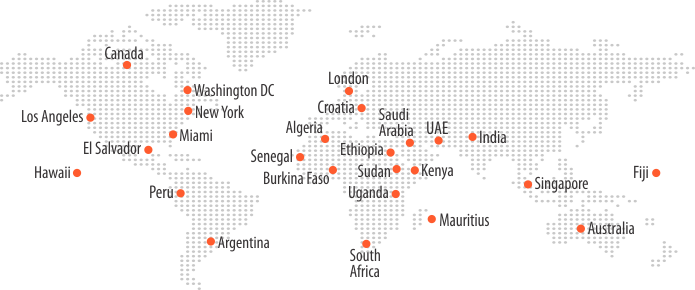How to Optimize VoIP Call Quality with Quality of Services

Voice over Internet Protocol (VoIP) is gradually making inroads into the enterprises looking to streamline their internal and external communication. It is projected that the global market for mobile VoIP, valued at US$46.9 billion in 2020, will reach US$183.7 billion by 2027, advancing at a CAGR of 21.5 %. While there are a number of VoIP providers offering a variety of VoIP packages with a range of features, businesses should consider the Quality of Service (QoS) of each service provider to determine which one best suits their business requirements.
Even with a good internet connection, some organizations face call quality concerns. Delays and unexpected silence during the calls can damage the credibility of the service providers and might cost business opportunities. QoS can address these issues that come along with the VoIP technology.
The QoS standards play an important role in enabling the routine operations for businesses which moreover relies on video conferencing, online training, and streaming of media. Businesses need to adjust as market requirements evolve. The QoS implementation process may be required to restart by reframing its goals, modifying and assessing designs, developing innovative designs, and analyzing to identify whether they match the revised goals.
Understanding QoS
Quality of Service (QoS) manages network traffic when it passes through a router to deliver suitable service to the users. Administrators utilize QoS to solve audio quality issues during a call.
VoIP is vulnerable to network congestion and causes echoes, delays, and call drops depending on the right sequencing of data packets arriving at their destination. High latency and jitters may create serious voice difficulties over IP connections.
Routers often use a FIFO (First In, First Out) approach to manage data packets, unless a different configuration such as QoS tagging is enabled. It may cause queuing troubles across the network if high bandwidth is used. QoS resolves this issue using network resources depending on the type of traffic and device.
How does QoS Work?
The QoS configuration allows the router to avert unnecessary disturbances and improves VoIP call quality. The router works to prevent other services from having an equal extent of priority, ensuring appropriate maintenance of data streaming and stabilize voice communication by prioritizing voice traffic.
QoS is a system that prioritizes some key packages for reaching the destination and slowdowns the most irrelevant packets. Such priority packets arrive at the destination as quickly as possible.
Recommended QoS Settings
QoS is a critical consideration for any VoIP system. The aim is to discover how packet traffic for voice or other media may be prevented from being delayed or disrupted owing to low priority traffic interruptions.
Businesses can use a variety of parameters to quantify QoS, such as:
Packet Loss
The number of packets lost after the transmission is measured by packet loss. Voice data packets are quite vulnerable to packet loss. Any packet loss greater than 3% will result in a severe degradation in audio quality.
Latency
Latency measures how long a packet takes to go from its source to its destination. There is some latency in all VoIP systems and networks. Voice data packets are vulnerable to the latency of more than 150 milliseconds per trip.
Network Jitter
It happens due to congestion of the network, and fluctuations in routes. The clarity of voice declines with jittering. In the case of real-time voice, packets arrive out of sequence with an unsteady network connection. Jitter over 30 milliseconds have a significant impact on voice calls.
Network Topology
The architecture of LAN and WAN networks decide if endpoints could be affected. LAN (Local Area Network) refers to the network maintained by the router, while WAN (Wide Area Network) is the extensive network of the Internet. VoIP packets arrive at the destination on WAN, traveling from the phones via LAN.
Implementation of QoS
Each router and network configuration is different, and the documentation shared by the network equipment provider is important when prioritizing voice traffic. Here are the three approaches to implement VoIP QoS:
Prioritize Network Traffic
The steady bandwidth required for VoIP traffic could result in a degradation of call quality even if it is a minor delay. It is desirable to prioritize network traffic by type ensuring the devices don’t dominate the network bandwidth. Rather, the nature of traffic defines the sequence.
Classify Network Traffic with DSCP 46
Various VoIP devices are utilized to categorize network traffic using a DSCP (Differentiated Services Code Point) header. It is recommended that both inbound and outbound RTP packets with DSCP 46 should be configured.
Setting up Trust Mode with Strict Priority
Advanced queuing processes are offered by more network switches and routers. Switches can detect DSCP packets due to Trust mode. They won’t be weighed with other devices owing to strict priority. Even if it isn’t as advanced as this, most routers feature some type of VoIP QoS.
Tackle Voice Call Quality Issues with QoS
Selecting a reliable VoIP provider is important for every business. Knowing QoS capability is crucial for successfully upgrading the infrastructure for a unified network and reaping all of the opportunities and advantages that come with it. Select an expert VoIP service provider that is well-versed in VoIP QoS to ensure that the business phone system operates with maximum efficiency.
With decades of experience and global presence, Bankai Group is a leader in wholesale VoIP service and retail voice service. We recognize that companies want dependable and versatile services to manage their systems and provide high-quality solutions to their customers. Our skilled and experienced professionals offer effective and efficient network management, improved network resilience, and reliable routing systems to MNOs, MVNOs, tier 1 carriers, calling card businesses, enterprise clients, and service providers.
Related Posts
The Next Big Thing In VoIP: Artificial Intelligence Integration
Telco Fraud Prevention Strategies And Revenue Assurance In The 5G Era






